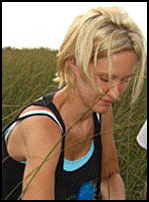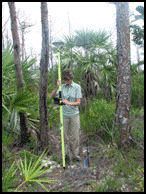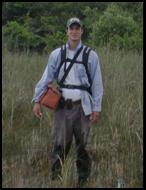

|
David Reed, M.S. - Environmental Studies 2007 |
|
Hillary Cooley, M.S. - Environmental Studies 2004 |
|
PALM FUEL DYNAMICS IN FIRE-SUSTAINED PINE FORESTS IN THE FLORIDA KEYS Abstract: In this study, the relationships between the time since last fire and the contributions of two palm species (Silverpalm, Coccothrinax argentata and Key Thatch Palm, Thrinax morrisii) to the burnable fuel load in the lower Florida Keys were examined. The population size distributions, effects of fire and plant size on mortality, annual growth rate, minimum reproductive size, and leaf moisture content of the palms were also determined. Regression models were developed to estimate the live and attached dead burnable biomass for both palm species. Equations with crown area and number of leaves as independent variables best predicted the amount of burnable biomass. Fuel accumulation was then modeled to determine the time until different biomass components begin to stabilize after fire. Live palm biomass continued to increase for approximately 2-5 years after fire, while dead attached biomass continued to increase for up to 15-20 years. In the burned sites a greater percent of mortality was observed in the larger palms. |
|
EFFECTS OF HYDROLOGY AND LIGHT ON SEEDLING ESTABLISHMENT AND GROWTH OF FOUR WETLAND TREE SPECIES IN TREE ISLANDS OF NORTHERN SHARK SLOUGH, EVERGLADES NATIONAL PARK Abstract: Vegetative communities within tree islands known as Bayheads are seasonally inundated and are associated with heterogeneous canopies. Establishment of dominant tree species is strongly affected by hydrology and light. The dominant forest species: Annona glabra, Chrysobalanus icaco, Magnolia virginiana, and Morella cerifera, were the focus of periodic field surveys in three Everglades tree islands. Season of seed-fall, germination, survival, and distribution of seedlings along micro-topographic and light gradients were quantified. Species’ life history traits for flood and shade tolerance, including plasticity in growth response and vigor were measured in experimentally controlled light and hydrologic treatments. Recruitment peaked during March-April, although survival was greatest with earlier establishment and with increasing light. Flood avoidance in A. glabra seedlings and flood tolerance of M. cerifera juveniles showed growth stage differences, revealing separate growth stage flood and shade tolerances. These bayhead-scale responses help to understand slough-scale flooding effects on regeneration and species composition. |
|
E-mail: erin.hanan@fiu.edu |
|
Danielle Ogurcak, Ph.D. Candidate - Earth Sciences |
|
The future of the endemic pine rockland community on the island of Big Pine Key, FL: The use of plant functional traits to predict successional trajectories resulting from the interaction of disturbance events and sea-level rise
Abstract: The endemic pine rockland community on Big Pine Key, FL provides an excellent opportunity to study how a catastrophic disturbance (like hurricane storm surge) affects a mid-successional freshwater upland community, as this community type occupies the highest elevations on the low-lying islands of the Lower Florida Keys and is reliant on disturbance (from fire in particular) to maintain an open canopy and prevent succession to hardwood hammock. Just such an event occurred on October 24, 2005, when storm surge from Hurricane Wilma flooded much of Big Pine Key with saltwater, leading to widespread death of pine trees and herbaceous vegetation. Plant functional traits will be used to study community response to increases in salinity from this event and changes in fire regime, as well as to test hypotheses about the interaction between disturbance regimes and sea-level rise. I propose to sample understory vegetation and to quantify electrical conductivity in an existing network of permanent plots located on Big Pine Key. Trajectory analysis will be used to analyze the temporal change in plot composition and storm-related changes in herbaceous plant abundances and diversity will be related to several variables, including: fire history, modeled storm surge, pine mortality, elevation, canopy cover/shrub encroachment, and soil salinity. An ecological community map of the island will be created using an ecological classification system of the Florida Keys. The map will provide a baseline for modeling possible changes in species assemblages as result of residual storm surge effects, future disturbances, and sea-level rise scenarios. The identification of specific plant functional traits related to species persistence and adaptation will provide a platform from which to make predictions on the likely trajectories of the ecological communities on the island of Big Pine Key as well as other low-lying oceanic islands and coastal systems under projected sea-level and disturbance regimes. |
|
Erin Hanan, M.S. - Environmental Studies 2008 |
|
Multi-Scaled Patterning of Plant-Soil-Water Interactions across Tree Islands and Marshes within the Prairie and Slough Landscapes of Everglades National Park Abstract: The freshwater Everglades is a complex system containing thousands of tree islands embedded within a marsh-grassland matrix. The tree island-marsh mosaic is shaped and maintained by hydrologic, edaphic and biological mechanisms that interact across multiple scales. Preserving tree islands requires a more integrated understanding of how scale-dependent phenomena interact in the larger freshwater system. The hierarchical patch dynamics paradigm provides a conceptual framework for exploring multi-scale interactions within complex systems. We use a three-tiered approach to examine the spatial variability and patterning of nutrients in relation to site parameters within and between two hydrologically defined Everglades landscapes: the freshwater Marl Prairie and the Ridge and Slough. Results were scale-dependent and complexly interrelated. Total carbon and nitrogen patterning were correlated with organic matter accumulation, driven by hydrologic conditions at the system scale. Total and bioavailable phosphorus were most strongly related to woody plant patterning within landscapes, and were found to be 3 to 11 times more concentrated in tree island soils compared to surrounding marshes. Resource islands in the slough were elongated in a downstream direction, indicating soil resource directional drift. Combined multi-scale results suggest that hydrology plays a significant role in landscape patterning and also the development and maintenance of tree islands. Once developed, tree islands appear to exert influence over the spatial distribution of nutrients, which can reciprocally affect other ecological processes. |

|
E-mail: reedd@fiu.edu |
|
E-mail: dogurcak@ufl.edu |


|
E-mail: Hillary_Cooley@nps.gov |









|
Michael Kline, Ph.D. Candidate — Earth Sciences |
|
E-mail: klinem@fiu.edu |
|
Suresh Subedi, M.S. Candidate — Environmental Studies |
|
Determination of nutrient limitation on trees growing in LILA tree islands
Abstract: Variation in the availability of nutrients at different sites affects the growth and productivity of plant species. As N and P (along with light) are the most frequent limiting factors for plant growth in wetlands, less nitrogen and more phosphorus are taken up when supplemental quantities of both nutrients are made available to plants growing under background conditions of relatively low P supply and high N supply. Under conditions of low nutrient supply, most species have lower concentrations of nutrients in their tissues, and in some cases plants may retranslocate a larger proportion of nutrients from senescing leaves. Fertilization experiments have proved successful in determining the growth-limiting nutrient in various ecosystems including wetlands. Plant species generally react to the increased supply of the limiting nutrient, but not the non-limiting one, with higher biomass production. The goals of this research are to determine the general patterns of response by tree species when conditions limiting optimal growth for the plant species are improved by fertilization and to determine the nature of nutrient limitation in a tree species growing on limestone and peat islands. I will examine background leaf N:P and N and P resorption in 2 species Annona glabra and Chrysobalanus icaco along the hydrologic gradient, by fertilizing with N and P (+ control) and characterizing their growth, leaf production, and leaf characteristics. I will work in all four M2 and M3 islands, which will allow me to quantify the interactions between hydrology and substrate (peat v limestone) on the nutrient economy of the two target species. This study will determine whether nutrient limitation is an important factor in the development of the tree islands, and will help in understanding N and P limitation to tree growth across a hydrological gradient and in contrasting soil environments. |
|
E-mail:subedi.suresh@gmail.com |


